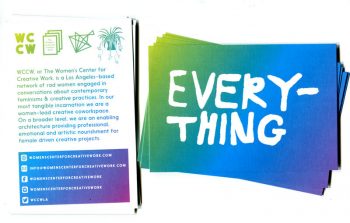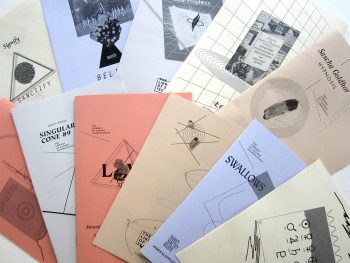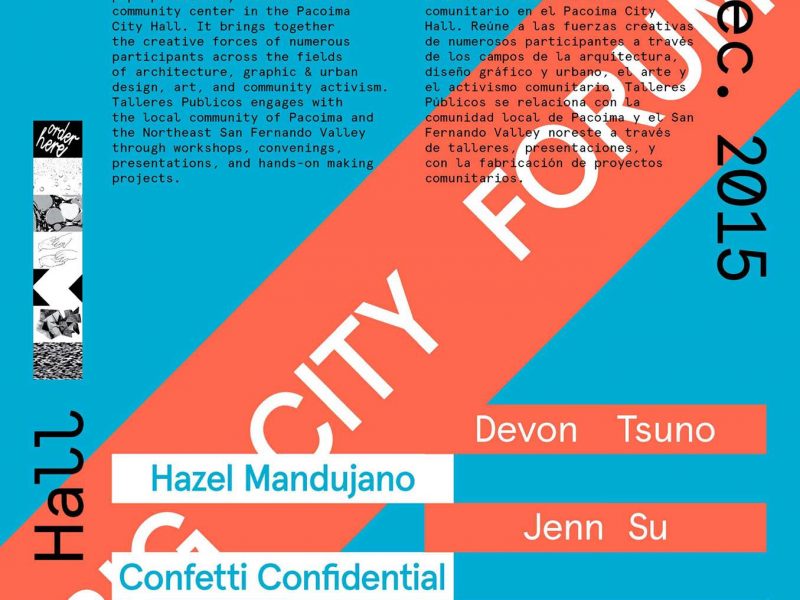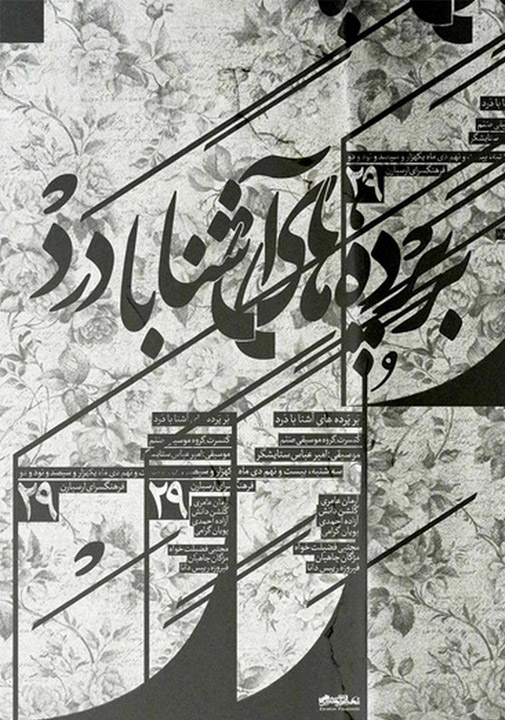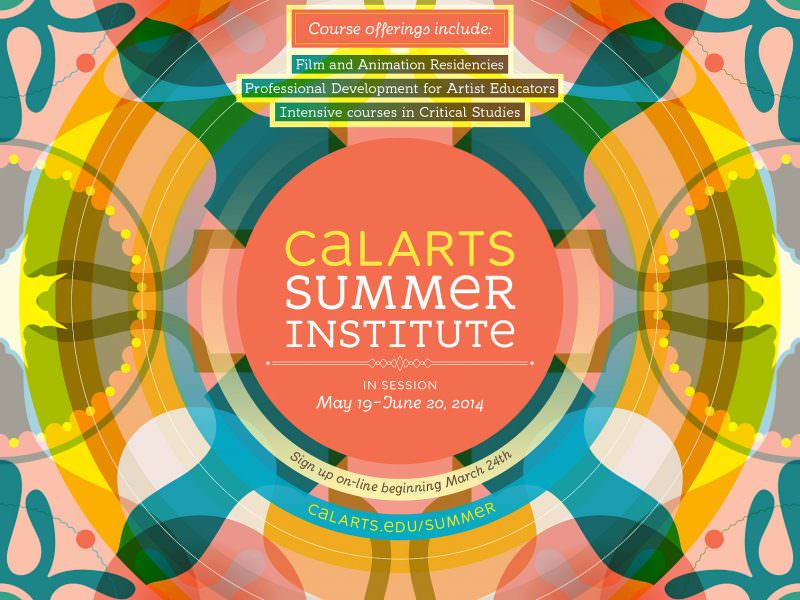The Women’s Center for Creative Work is dedicated bringing the invisible narratives of labor into a place of preference. The way towards a financially viable independent graphic design practice can be murky, especially for students directly following graduation. With this discussion between three female alumna with independant Los Angeles-based graphic design practices: WCCW creator Kate Johnston (’12) design educator/practitioner Tanya Rubbak (’07) and design practitioner Jessica Fleischmann (’01), we seek to create an exportable model for running such a practice by delineating each of our own trajectories and realities.
We cover such important topics as community organizing, astrology, art collaboration, speculative design projects, maxing out credit cards, client work for cultural clients, client work for commercial clients, pantsuits, teaching, education administration, making ugly work, running organizations, positive feedback loops, self-initiated publication projects, working with non graphic designers, applying design process to everyday life, feminist design histories and utopian jumpsuits.
KJ: I’d like to begin by describing how these trajectories started for each of us. Let’s each chronicle our first few years after graduating, how did it feel after leaving CalArts and what steps did we take to pay our rent?
JF: My first few years after CalArts were as an “apprentice” in Lorraine Wild’s studio, and then as Art Director of a magazine that Lorraine and I designed the first issue and template of, Western Interiors and Design. I say “apprentice” because in that studio I learned about how to practice, how to interact with clients, how to make real work (which is much more long-term and less “exciting” than a class project but far more fulfilling), as well as how to remain engaged with the outside world while learning how to make that work in collaboration with the other designers in the studio. Even though I’d taken art classes all through elementary and high school, I didn’t have any undergraduate training in graphic design, so even though I did the three-year PMFA program, I had a LOT to learn about design.
After leaving CalArts, it took a few years for me to feel comfortable even returning to campus. The trauma of the grad program does wear off after a while. Though I’ve thrown out practically all the work I did there. It’s really pretty embarrassing!
TR: Jessica, I don’t believe that. But I relate, I didn’t have any undergraduate training in design either.
JF: Ask the faculty. My final review—ask Anne Burdick about that! No really, it was all so awkward and under-structured. There was some interesting work—partly because I didn’t have the training. But mostly really bad. Like not good bad, bad bad.
KJ: I only graduated 3 years ago… I definitely also threw out all of that PMFA work! My stuff that first year was also awful, formally at least. Its funny because I had been working as an in house designer at FIDM for three years before coming to CalArts, I was totally capable of making fine-looking work, but that didn’t seem helpful at the time. I wanted to start from the very beginning, tear everything down and build it back up. My thesis was really exciting for me, it was the year of Occupy Wall Street and I got very involved with that, I was so excited that there could be a movement around simply being in a space, occupying it without demands, opening a narrative as radical act. For my thesis I created a political party, I wrote all these manifestos, had meetings and political dinner parties, and created all the graphic language and messaging. It felt really right. After I graduated I went right back to work for FIDM, only freelance instead of full time. It felt like a weird time warp, like school had not even happened. I was still full of that thesis energy and would wake up in the middle of the night with ideas. I would write them down in my journal. One night I woke up and wrote “The Women’s Center for Creative Work.” In the morning I was still excited about it, I had this vision of running a community women’s center. I missed working in the CalArts studio and wanted to work in an intentional community again. Since then I have been working to create and maintain the WCCW. I’m really lucky to have found an amazing collaborator in Sarah Williams. She is an arts administrator and producer, not a graphic designer, and our project benefits immensely from our having two very different skill sets.
TR: Your thesis project sounds amazing! I love how it informs what you’re doing now with WCCW.
After CalArts I went to work for an architecture studio as an in-house designer. It was a job similar to the one I had before school and felt like a time-warp. I had all these ideas but had a hard time starting anything. And I was interested in doing “design theory” by making work.
JF: Exactly! Making as thinking. & wow, Kate, only out 3 years! It seems like you, and WCCW, have always been. Natural.
KJ: Haha thanks! That’s awesome to hear!
TR: I also started teaching and wanted to pursue that seriously. I quit my day job in the middle of the 2008-09 housing crisis and tried to live on teaching 2 classes, a little bit of freelance and credit cards.
Early post grad school inspiration came when I stumbled upon an estate-sale of a psychic and astrologer who had passed away at 97. The house was full of amazing things. I found some placemats (called Space Mats!) by April Greiman sent directly from April’s studio in the 80s; a box of occult publications from the 50s and 60s and an unpublished manuscript from 1932 by Annie Besant, a socialist, women’s right’s activist and famous theosophist.
It was also lucky when I met Adam Overton with whom I collaborated for a few years. That pamphlet collection inspired The Library of Sacred Technologies and Signify, Sanctify, Believe, a collaborative project with Adam and Claire Cronin. We created a fictional religious center where you could try on temporary religions designed by other artists, questioning how belief systems are formed, looking at intersections of art and religion. The library invited artists to contribute work and I made a series of 30 tracts, one for each contribution.
KJ: I remember the first time I saw your work, I picked up some of the Signify, Sanctify, Believe stuff in POP-HOP on York! It was right after I graduated and it inspired me; I realized I could still make invigorating stuff after leaving school, I didn’t have to only make commercial work!
TR: That is so so nice to hear!
JF: It seems like 2008-9 was a pivotal year. The financial crisis made a lot of things shift. There’s nothing like having limited options to find out what you really want to do. I got laid off from the magazine (which was the best thing that could have happened in the end, I got a decent severance, and the magazine folded about a year after I left), and those few months salary helped me start my own studio. I had no idea what I was doing or how to get clients, but an old family friend needed a brochure and some postcards for what seemed like a reasonable fee. It turned out to be not nearly enough $$ for the amount of time, number of rounds of corrections, endless photo retouching, etc. and the fact that you’ll never see that piece in my portfolio. Not that it was that bad, but it wasn’t very good either. It didn’t do or say anything interesting, because I allowed the client to be the boss. It helped me crystallize how much I only want to do work that I’m willing to publish with my name on it.
TR: I had no idea this is how and when you started your studio. It seems like it’s been around for much longer. I do think that these hard negative seeming things are mostly opportunities. Quitting my job in the middle of the financial crisis was scary, but totally pushed me to start doing what I wanted.
KJ: It’s true, you can’t find yourself without letting go of certain things, often that involves jumping into something really scary, but I feel it’s always totally worth it. What constitutes your practices today?

Yellow Grid by Line journals from still room, 2015
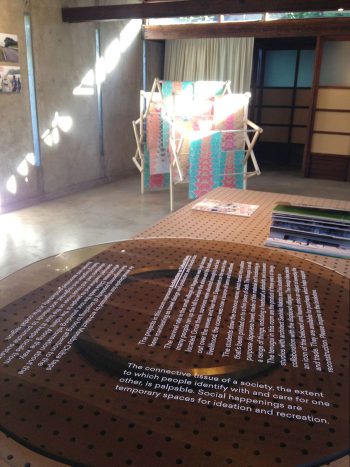
GroundSwell: Guerilla Architecture in Response to the Great East Japan Earthquake, 2015. Exhibition design by Group Effort: Jessica Fleischmann & Rachel Allen with Dorothy Lin. Photo by Joshua White.
JF: Practice is mostly service. I see myself as a service provider more than anything else. It takes form as ink on paper or pixels on screen, sometimes packaging, or increasingly as 3-d spaces.
But mostly I help people form their questions, re-define their needs, and hopefully see beyond what they’d expected to end up with. It’s my job to make visual sense of the client’s content for their audience, to make their ideas, images, words clear in a way that is also surprising, that communicates more about what they’re saying than the text and images that they walked into the studio with. One of my main goals is to help people go beyond their boundaries, to make them something unexpected yet utterly satisfying.
On a practical level, it means going to an office every day, answering emails, looking at my bookshelf every now and then, and making work for clients. Sometimes chasing down payment. The boring business part.
Also on a practical level, it means collaborating with my studiomates, an architect (Rachel Allen) and a landscape architect (Allen Compton). Sharing a space with them challenges all three of us to expand our practices in ways that are sometimes almost alchemical.
My clients are mostly cultural, which includes food, performance, architecture, artists, the library. I work both with individuals and institutions. I’ve also just started to develop a stationary line, foil-stamped note cards and notebooks, based on my experience working with foil. Something really simple, yet with a lot of thought and research in it.
Basically it’s my job to get out of the way.
KJ: I totally see myself as a service provider too! I see the simple act identifying a need and working to solve that need for pay as a deeply important endeavor. I have no problem identifying myself with the same word one uses for a mechanic. Mechanics are valuable people, especially in LA, they run this city, actually! To pay my bills I provide graphic design services. I do a lot of commercial freelance, run of the mill marketing stuff. I get a lot out of it, even if I don’t necessarily put it on my portfolio. Any time there are a range of limitations and some type to be set and a paycheck on the way I’m happy. It gets harder when there is no paycheck on the way. My personal projects, Pants Magazine and the WCCW, take up at least 30 hours of my week. Neither project as of yet has a substantial funding structure. In general I don’t approve of working for free, but when its your own project it’s par for the course. That gets hard though, some months I have to put all my bills on my credit card.
I’m working at home until we can figure out a space for the WCCW. I honestly can’t wait for that day to come, because I agree that it’s so exciting and potentially expansive for a practice be sharing a space with people with different disciplines, like your situation Jessica. Working at home has its quirks. I seriously do a lot of washing dishes! I find it very meditative. Also organizing my workspace is a big part of my practice, I spend the first part of every day putting things in order and making sure my teacup lines up perfectly with my sharpies or whatever. I know it’s ocd, but it puts my mind into a pace where I am ready to work. I also believe in wearing “work clothes” even though I’m working at home. That doesn’t mean a pantsuit or whatever, but I feel like I need to dress as if I’m ready to take a meeting while I’m working. If I stay in my pajamas I’m likely to just go back to bed.
TR: It gets really hard without having a funding structure for these projects. Not that I believe in working for free, but doing something that you believe in seems completely worth it even if you have to put it on your credit card. What else are they for? It does come back around eventually, maybe in ways that we may not have imagined yet. It’s a delicate balance between faith and fear. I think you do the things that you want first and then everything else will happen. Call it a Positive Feedback Loop of offering gifts to the gods.
I love that you said “pantsuit”! When is the next Pants Magazine coming out?! Are you a Virgo? I think Jessica is.
My practice is made up of a bunch of things. Teaching is a big part and has been most consistent. I recently started doing more client work and enjoyed several collaborations with other designers. I feel grateful for these experiences. (A few books with Mark Owens and Made in L.A. catalog with Kimberly Varella of Content Object)
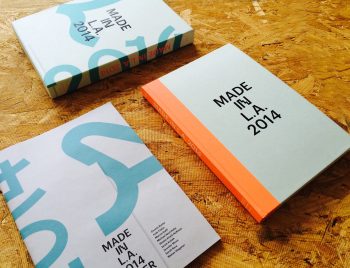
Tanya Rubbak, Made in L.A Catalogue, co-designed with Kimberly Varella, 2014
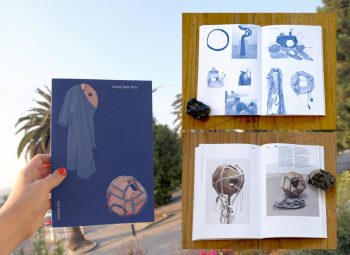
Tanya Rubbak, Anna Sew Hoy / Suppose and a Pair of Jeans / co-designed with Mark Owens, 2013
TR: And then there are more speculative art/design projects, working with design history as a medium and a site for engagement with other subjects such as the SSB and The Bureau Experimental Speech and Holy Thesis collaborations with Adam.
Now I’m working in a similar way with Brian Getnick on Native Strategies, a performance art journal. This past summer we did a project at LACE where the journal became a three dimensional space and a performance structure.
I’ve been thinking about design and performance a lot. How do you capture something ephemeral that requires presence; how can you activate a document and let it perform as well; or how the space shapes the performance. Design is already performative. It does so visually, speaking in different vernaculars or structurally when the organizing principle takes cues from the content. It’s almost like method acting, becoming that which it represents, or the other way around, creating by representation.
KJ: That’s really interesting because it acknowledges that each piece, each designed thing, perhaps, has its own being or essence that needs to express itself on its own terms. A project requires presence. It will show you how it needs to realize itself as you work on it. This is another connection to performance: you have to enter into the space of a project and allow it to be completed on its own terms without judgement. I often forget this and focus only on use: “how will this thing be used and what is the most efficient way to enable this use”? But pragmatism by itself neglects that mystical essence.
I’m an Aquarius, by the way, but a weirdly organized one I think. And Pants Magazine 3 might take a while to come out! I’m trying to figure out a funding structure for printing that thing.
TR: It makes sense that you’re an Aquarius. Aquarius relates to communities and society at large, as well as belief systems, and the collective unconscious. It’s ruled by Uranus, the revolutionary!
JF:I love that you guys are bringing horoscopes into it. I’m a Virgo only in the sense that I like things to be a certain way, have a vision about how things can be. But my desk, my house, not neat. Dishes, no thanks. I’m on the cusp of Libra, which I think shows up way more. I like to weigh out all the options, balance possibilities. Sometime a little too much…
TR: Our birthdays are a day apart! I like options too. And I’m hyper-organized and messy at the same type.
JF: Though I’m a Virgo, I’m not the super tidy kind. I WISH that organizing my space was part of my practice! I end up organizing stuff—ideas, words, images—for other people’s projects. But the shoemaker’s children…
TR: Well that reminds me that I’ve been thinking a lot about how to apply design skills to my life more (so new agey!)
JF: That’s not new agey at all, Tanya! It’s amazing that you’re bringing this up. I’ve been thinking a lot lately about “designing my life”, applying the training and skills and practice that I use in my work for other people to my own personal organization. Design is concrete—you get an assignment, you set a schedule, you get content, you do something with it, you meet deadlines, you send it to the printer or programmer or you print or program it yourself, and then it’s done. It goes out into the world as an object that seems complete and inevitable. And maybe even effortless. I can barely imagine how satisfying it would be to apply design process to structure my everyday life.
This is why you need to bill clients along the way, while they remember the process, how intensive and thorough it was, and close out the final bill before you send files to printer. Even once is one time too many to hear “But you just used the pictures I gave you. How is it possible that that took ten hours?”
TR: Right! It’s fun to imagine approaching daily activities and life problems as a design project. It’s questions that we’re so used to thinking about, like defining the problem, coming up with an idea, (or many ideas! ) figuring out an interesting structure, finding visual references, tones, typographic (or other) palettes, determining information hierarchies, and trying many iterations. I wish I could do that better with my life events.
KJ: I love this. I have a utopian fantasy of only having one practice and applying it to everything: my work, my domestic partnerships, grocery shopping, all of it. It would have to be a very flexible model, but I like the idea of creating a model that cohesive and plastic. This utopia also invariably involves jumpsuits of some kind, or at least multi-use aprons.
What role do you guys think these “non-design” activities play in your practices? do they qualify as personal projects?
TR: I think they qualify as being another aspect of your practice/life. And it seems pragmatic to consider “non-design” activities these days. A lot of what we learn (and teach) in design school is a process-based way of thinking that can be applied to anything. Though it’s a little abstract to step away from setting type and making form, it’s not really. We’re always editing, helping crystallize content by asking questions, coming up with methodologies, thinking of large systems that can be applied to many mediums and experiences. Or even asking why make something in the first place, maybe another thing is a better idea. Jessica described this earlier too.
With form-making getting more automated and being much easier to learn, the requirements for high levels of formal refinement are changing. We now mostly look at design online, while the idea of information is more important then ever. If you take a lot of the form out of the question, what can you bring as a designer?
I went on a tangent… The other day I was walking around the reservoir and I was thinking about this idea of designing “non-design” activities. So I imagined making a book out what I was seeing. I started focusing on specific features, like tree-bark patterns, or the contours of branches, types of leafs. The number of steps to breath became a grid. And it really worked and made me see much more and whole experience richer.
KJ: I think about how wide a design practice can be all the time! I only spend about 33% of my time with WCCW doing “traditional” graphic design. The other 69% is administrative and writing. My approach to all activities is the same, this process-based way of thinking that can be applied to anything, as you called it Tanya. If design can be defined by this process-based thinking then we can say that all activities undertaken in a process-based way can be design. Not only the poster, the book and the website, but writing, programming, and throwing parties are also design endeavors, just as long as there is a process and intention. Event planning is a very designed activity! For example WCCW was invited to host something the Craft and Folk art Museum a few months ago. We researched the history of the institution at the UCLA archives, created programming around that research, and then solidified the whole thing as an exportable model that we can now reenact in future site-specific locations with site-specific content. The only “traditional design” artefact from that event is a broadsheet I made, but the whole event was designed and executed using the exact the same methods I use to execute any sort of traditional piece. I want to claim all intentional programming and execution as designed media.
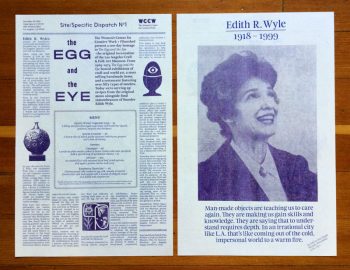
Kate Johnston, The Egg and the Eye Broadsheet, WCCW Site Specific Dispatch #1 from Craft and Folk Art Museum. 2014
JF: My home and studio are really important places to me. They are very considered, and “designed”, not self-consciously but as an extension of who I am and how I see things. Objects and their placement really matter. It’s a way of telling stories, of making sense of the world.
More and more, my house is filled with artwork that clients have given me in trade for design. I’m really fortunate in that I’m able to earn enough to get by on AND do some projects pro-bono or for trade.
It’s funny, the one CalArts project that keeps coming back to me is when we went to the desert and had to give a presentation on something we’re obsessed with. My obsession was with space, just the sense of space even without anything in it. The quality of light. The feel of the air. The ineffable. I don’t think my presentation was very compelling—I asked everyone to close their eyes and picture what wasn’t there or something like that. Kind of undercooked grad school stuff. If I did it now I’d do a bunch of research and present how other artists and thinkers represented the ineffable. But I guess that’s what you do in school: fail. What this has to do with “non-design” activities actually feeds right into my practice: I’m interested in conjuring a space of possibility that doesn’t need explaining or success. I think failure needs to be given much more attention…
TR: I still cringe from school fail moments, like my genealogy project in MFA 1 year. But that process helped a lot in moving forward. I wonder how to include this long-winded series of false-starts and iterations into client work. If I put that kind of energy into something, I end up making 5 cents.
Jessica, do you have thoughts about this? How do you deal with process, time and compensation?
JF: Oof! You do the best you can with the resources you’ve got, time as well as budget. You try to build it in. Though it’s almost never possible to bill for all the hours worked.
There’s also the process work that happens in the background, through just being in the world and thinking in form. The way a designer does.
I try to also look as much as possible at references, other design, art, nature, paying attention as much as I can stand it to the news. Part of it is that after 10+ years, I’m much more facile with type, and I’ve usually got some typographic ideas brewing whether a client wants to use them or not. I think in form a lot, even if I’m not thinking about a specific design, ideas/form.
TR: Yeah I got faster in making form and thinking in type with more experience too. Though I still throw away 2/3 of what I make, I can now make it faster, or sometimes just imagine it and move on.
KJ: I like the idea of making in your head, just imagining like the first 3 iterations of something so by the time you create a new file you’re on #4 and it’s almost done… mental design! I am not quite there yet, but I do have to say it’s getting easier.
Who are your biggest clients/sources of income? How did your relationship with them begin, and how have you maintained those relationships over the years?

Jessica Fleischmann, spread from 2013 RADAR L.A. brochure.
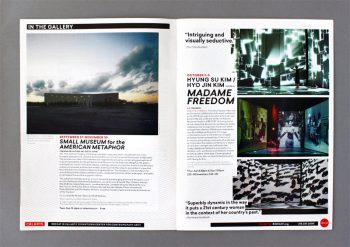
Jessica Fleischmann, spread from REDCAT 2015 Brochure
JF: My number one client is REDCAT. In 2010, Scott Taylor (who was then Design Director at CalArts) asked me to design REDCAT’s New Original Works Festival brochure. He’d seen a low budget book I did (for free or practically free) that used 4-color process in a very straightforward way, and also I think a pretty bold newsprint piece (that I also designed for practically free), and he knew that I could use ink (and a low budget) effectively. I LOVED that project. It was the first real validation I’d gotten as an independent designer both professionally/emotionally and financially. Before that, it was either one or the other…
As for maintaining the relationship, that’s what it really is, a relationship.
It transforms along the way, but basically there is trust and mutual respect. I believe in what they’re doing, and do my best to represent very diverse programming in a clear, straightforward, and enthusiastic manner.
KJ: I remember when you got that account! I was interning with Scott Tylor in the publications office at the time. I remember thinking, “Wow, will I ever be at the point in my life when I am a valid enough person/designer to get a whole account like REDCAT?”
JF: You’re there if you want/need to be! Basically, I believe you’re ready for whatever comes your way. Even though I knew I could do it, and make something clear and amazing, I don’t think I felt ready. I felt really, really lucky.
TR: My number one client might be Otis College of Art and Design, where I teach. It’s the longest job I’ve ever had (6 years) and I’ve been getting more involved in the department. I took on the Interim Assistant Chair job for the spring semester and it feels similar to doing large art projects involving many people, planning, and day-to-day administration and tasks. It’s been amazing working with Kali Nikitas and seeing how she develops and runs the program. Running a design program is a massive design project.
While I have a hard time seeing design as a service, work at school is more service-like for me. It’s been about advising students on majors and classes, figuring out their credits, making sure they graduate on time. With design, there are so many variables and degrees of authorship and so often we make the content by shaping it. I think of it more as a collaboration. At school the goals are clearly about the students, their work outcomes and development.
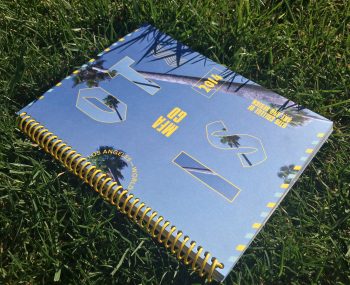
Tanya Rubbak, OTIS MFA Lookbook, 2014
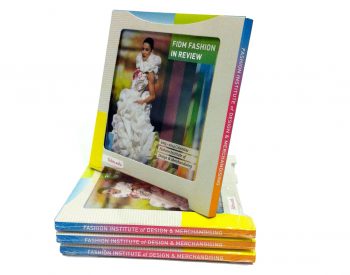
Kate Johnston, Di-cut Desk Calendar, promo piece for FIDM educators, 2014
KJ: My main client is still FIDM, they have been very good to me and freelancing for them enables everything else I do. They’re my day job, so to speak. I make marketing materials for their publications department, some of the same jobs I’ve worked on since before even going to CalArts. I feel like they are a supportive family member.
I totally agree that there are varied and nuanced things design can be. I speak of design as a service as both a commercial practitioner and a community organizer. With commercial work I see a very cut and dry exchange: you pay me and I make stuff for you. This is a service I provide, and it’s mutually beneficial.
As a community organizer it is my goal to provide a service to my community. The WCCW is a space I created and maintain to serve the female and female identifying creative community of Los Angeles by running a creative co-workspace and providing professional, emotional & artistic nourishment for female-driven creative projects and practices. I want to provide work that is helpful to people, that serves them.
But then, there are those other projects, like Pants Magazine, that I make because I want to make them, I make them in service to myself. Is that still providing a service or it it something else?
TR: Yeah, it’s communal and participatory and a dialog about an object. It’s interesting to ask what or whom does it “serve” when you make something. I think ok and pretty great even if it only serves you! But then it might inspire someone in the future.
KJ: Totally. Speaking of the communal things, do you guys see yourselves as part of a community of female designers in Los Angeles?
JF: There’s a small supportive circle of “my generation” of women designers. And there’s my mentors, Louise and Lorraine and other women who paved the way. Gere Kavanaugh used to have an office down the street, always inspiring running into her, and it’s nice running into some of the younger women who work nearby (Lucy Cook & Thea Lorentzen). Though I don’t often hang out with a lot of designers…
TR: Sure, but it would be nice to connect more. Maybe WCCW can do more design events! I do feel connected to the history of women designers in L.A.
JF: Yes, more design events. Kate, how can Tanya and I help?!
KJ: You’re doing it right now! Its funny, graphic design can be a solitary endeavor, I feel like one has to be very intentional about creating communities around it. This conversation is a gesture towards that intention. That being said, there are a lot of great women working in design today in this city, many in collaborative ways. I’m part of an amazing collage group with female graphic design alums, Confetti Confidential, which is based around eating dinner together, making work side by side and then talking about our work in a casual way. I know there are other collage groups that follow the same model. It feels very female to include nourishment in a practice, snacks are so important! The feminist history of Los Angeles is very alive for me. WCCW is inspired by the historic Womans Building. That project came out of CalArts, albeit as a form of resistance to the pedagogy there in the 1970’s. One thing that can be toxic to community is unhealthy competition. I think designers can be reticent to share information if they are all competing for the same jobs. It’s my wager that the feeling of scarcity about design work is due to a damaging myth that the only jobs worth taking are high-profile cultural projects. There are so many other sorts of jobs! Sure they may not be as glamorous, but if they pay the bills then they allow you to tend to meaningful personal projects. There is bounty of graphic design work in this city. If we share resources and client info we empower ourselves collectively and everyone wins.
